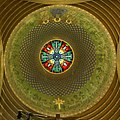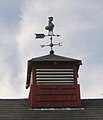Cupola
In architecture, a cupola /ˈkjuːpələ/, sometimes US: /ˈkuːpələ/,[1] is a relatively small, most often dome-like, tall structure on top of a building.[2] Often used to provide a lookout or to admit light and air, it usually crowns a larger roof or dome.[3][4]
The word derives, via Italian, from lower Latin cupula (classical Latin cupella from Greek κύπελλον kupellon) 'small cup' (Latin cupa) indicating a vault resembling an upside-down cup.[a]
Background[]
The cupola evolved during the Renaissance from the older oculus. Being weatherproof, the cupola was better suited to the wetter climates of northern Europe.[citation needed] The chhatri, seen in Indian architecture, fits the definition of a cupola when it is used atop a larger structure.[citation needed]
Cupolas often serve as a belfry, belvedere, or roof lantern above a main roof. In other cases they may crown a spire, tower, or turret.[4] Barns often have cupolas for ventilation.[5][6]
Cupolas can also appear as small buildings in their own right.
The square, dome-like segment of a North American railroad train caboose that contains the second-level or "angel" seats is also called a cupola.[7][8]
Gallery[]

White marble cupolas cap minarets at the Tomb of Jahangir in Lahore, Pakistan
Cupolas on the towers of Montefiascone Cathedral, Italy.

Ribbed cupola crowns the minaret of the Mosque of Uqba, in Kairouan, Tunisia.

Inside of Armenian Orthodox church cupola in Lviv, Ukraine.

Cupolas were also used on some old barns for ventilation.

View from the interior of Cupola module on the International Space Station.

Trompe-l'œil painting of a cupola in a church in Northern Italy (Brivio)

A cupola-style caboose with an "angel seat" above
See also[]
| Wikimedia Commons has media related to Cupolas. |
Notes[]
- ^ In Italian cupola simply means 'dome', and the ornamental top element is called lanterna.
References[]
- ^ Merriam-Webster's Unabridged Dictionary. Springfield, MA: Merriam-Webster, Incorporated. 2000.
Pronunciation: ˈkyüpələ, ÷-pəˌlō sometimes ÷ˈkü- or ÷-pyə-
- ^ "Glossary of Architectural Terms - C". Archiseek: Online Architecture Resources. Archived from the original on 27 December 2008. Retrieved 3 January 2009.
- ^ "cupola". The American Heritage Dictionary of the English Language, Fifth Edition. Houghton Mifflin Harcourt Publishing Company. 2014. Retrieved 26 April 2015.
- ^ Jump up to: a b "Just what is a cupola anyway?". Cupola Consulting. Retrieved 3 January 2009.
- ^ "What is a cupola and why do barns have them?". Retrieved 15 November 2015.
- ^ Active Interest Media, Inc. (November 1980). Old-House Journal. Active Interest Media, Inc. p. 177. ISSN 0094-0178.
- ^ "Railroad Dictionary: A". CSX.com. CSX Transportation. Archived from the original on 1 August 2015. Retrieved 18 September 2014.
- ^ Zabel, Darcy (2005). The (Underground) Railroad in African American Literature. Peter Lang. p. 5. ISBN 9780820468167.
- Architectural elements
- Domes









